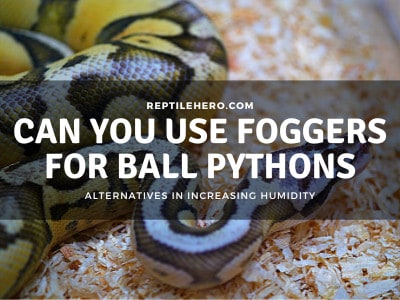Can You Cohabitate a Ball Python With a Leopard Gecko?
Do you keep both a ball python and leopard gecko as your pets? Then you are probably curious about whether they can live together or not. The cohabitation of different species often pose risks and can quickly go downhill with just a few mistakes!
As a general rule, ball pythons should not cohabit with a leopard gecko in a single tank. There are no benefits to housing them together. If forced to live in the same enclosure, both reptiles can suffer from husbandry issues and predation may ensue.
Ball pythons are solitary creatures and have a hard time cohabitating with most animals. Will a ball python eat reptiles such as lizards? Why is cohabitation an unpopular practice in keeping ball pythons? Learn about these shocking facts as you read below!
Why You Should Not Cohab a Ball Python With a Leopard Gecko (Husbandry Comparison)
Ball pythons and leopard geckos cannot cohabit due to having different husbandries. More importantly, ball pythons also have the potential to seriously harm and prey on the leopard gecko.
Warning: Even if some keepers have posted a ball python and a leopard gecko living in one tank, I still highly discourage anyone who attempts this setup. It has no benefits and will only cause unnecessary risks to both animals.
| Husbandry | Ball Python | Leopard Gecko |
| Temperature | 75-80°F for the cold side, 80-85°F for the ambient warm side temp, and 90-92°F for the basking spot. | 70-80°F for the cold side, 85-90°F for the ambient temp, and 95-100°F for the basking spot. |
| Humidity | 60-70%, 80% when about to shed | 35–65% overall, 60–80% in the moist hide% |
| Diet | Carnivorous: Rodents and Birds | Insectivore: Insects dusted with calcium powder and/or other supplements |
| Enclosure Size | 48in x 24in x 24in (Full-grown) | 36in x 18in x 18in (Full-grown) |
| UVB Requirement | Use a mild UVB tube light (5%) | Use a mild UVB tube light (5%) |
| Active Time | Crepuscular or Nocturnal | Crepuscular or Nocturnal |
Similarities Between Ball Pythons and Leopard Geckos
When comparing husbandry parameters, ball pythons and leopard geckos have similar requirements, namely: 1) ambient temperature, 2) UVB level, and 3) active time.
1. Ambient Temperature
In the wild, both ball pythons and leopard geckos live in a warm environment, the former is located in Sub-saharan Africa while the latter is in the Middle East.
Keepers of ball pythons and leopard geckos even say that they keep their animals in the same room, sharing the same ambient temperature and there have been no problems at all.
2. UVB Level
Both ball pythons and leopard geckos need low-intensity UVB light. Based on their behavior in the wild, they are often seen during dawn and dusk basking in low sunlight.
Even though some keepers don’t use UVB, it is proven that they can get benefit from a mild UVB (5%) like having better D3 absorption.
3. Active Time
Ball pythons and leopard geckos can be crepuscular (active during dusk/dawn) and nocturnal (active during nighttime).
This means that you can keep a ball python and a leopard gecko in the same room without worrying about a different night and day cycle.
Differences
Ball pythons and leopard geckos should not cohabit due to their differences in care like: 1) basking temperature, 2) humidity, 3) diet, and 4) enclosure size.
1. Basking Temperature
Unlike a ball python’s basking temperature (90–92°F), leopard geckos need a bit higher basking temperature (90–100°F).
Ball pythons are much more prone to overheating and cannot handle temperatures higher than 95°F, unlike leopard geckos.
2. Humidity
Interestingly enough, both have a high chance of having illnesses and other problems if their humidity requirements are swapped.
Ball pythons can have respiratory infections and shedding problems in 40% humidity and below. While leopard geckos can have respiratory and parasitic diseases in the humidity range of 70% and above.
3. Diet
Another contrasting husbandry requirement is their diet. Ball pythons are carnivores, which puts its cohabitating leopard gecko at a high risk of being preyed on due to its smaller size and accessibility to the python.

Even if the leopard gecko does not get eaten by the ball python, the smaller gecko can still get attacked. In other words, just don’t cohab a ball python and a leopard gecko!
In response, the leopard gecko may drop its tail so it can escape the python’s attention [1]. This removal can cause high levels of stress to them.
4. Enclosure Size
The standard size of an adult leopard gecko enclosure is not recommended for an adult ball python. Ball pythons need more area to be able to stretch their bodies if they want to.
Even though most ball pythons hide all day, they are known to explore during the nighttime which therefore needs more roaming space compared to a smaller animal like a leopard gecko.
Will a Ball Python Eat Other Reptiles Like Lizards?
Ball pythons can eat reptiles ranging from lizards to snakes as long as it is a manageable size. Ball pythons are opportunistic hunters and will eat most animals that they can manage to kill.
There are many reports of ball pythons eating lizards, especially hatchlings in the wild with limited options of prey.
In relation to this, ball pythons can eat reptiles because there are circumstances when they have shown cannibalization by eating a ball python placed in the same enclosure.
One breeder shared their experience with ball python cannibalization which happened unexpectedly. He placed 3 ball pythons in one tub on the way to a reptile expo and when he opened the tub, one snake have swallowed another one whole.
Warning: Scenarios mentioned demonstrate how desperate a ball python can be, as an opportunistic hunter. That is why cohabitation with other ball pythons and reptiles is not recommended.
>>Learn about feeders suitable for ball pythons in our article about feeding mice and rats to ball pythons
Are There Animals You Can Cohabit With a Ball Python?
The only recommended animals for ball python cohabitation are small beneficial invertebrates. Such are insects include isopods and springtails which are typically present in bioactive setups.
Isopods and springtails can thrive in a ball python setup since the humidity is moderate-high. They won’t bite or cause harm to your ball python and would not be preyed on due to their small size.
Cleanup crews (CUC) can eat your snake’s droppings and some can also eat mold, which is one of the main causes of scale rot in ball pythons [3].
>>Learn more about cleanup crews and bioactive setups in our article about making bioactive substrates
Most keepers that have kept a thriving CUC colony in their ball python enclosure often found that they greatly help in the disposal of decaying matter like leaves and snake droppings.
Pro Tip: Even if you have a bioactive setup for a ball python, weekly spot cleaning is still recommended depending on how big your CUC colony is. Isopods will typically wait for a dropping to dry out before it feeds on it which can take about a week or two.
This is unsanitary for your ball python if the poop is left uncleaned and accumulates in their tank. In addition to high humidity, bacteria from the poop can cause scale rots and other kinds of infections.
Plus, ball pythons do urinate and the clean-up crews cannot clean it up. For a setup with no plants, 50–70% substrate change every 6–12 months is needed to avoid nitrate build-up.
Further Questions
Do ball pythons bite?
Ball pythons can bite as a defense mechanism or as a feeding response. Before striking defensively, ball pythons typically hiss and expand their bodies to warn possible predators that they will attack. Most of the time, they defend themselves by curling up into a ball.
Can ball pythons cohabit with other ball pythons?
In some cases, multiple wild ball pythons are found in one burrow. Although it is possible, ball python cohabitation can cause risks like injuries and even cannibalization, especially with limited space in captivity.
Can ball pythons eat a bearded dragon?
In theory, ball pythons can eat a bearded dragon as long as it is a manageable size for them. They do not encounter each other in the wild so there is no evidence of whether or not a ball python can eat a bearded dragon.
Summary of Cohabitating a Ball Python and a Leopard Gecko
In general, ball pythons should not cohabitate with a leopard gecko due to their difference in husbandry requirements and the risk of predation from the python. Ball pythons can eat reptiles like other snakes and lizards, especially if they are desperate to eat.
For cohabitation, cleanup crews like isopods and springtails are the most recommended for ball pythons. CUCs are detritivores which means that they feed on decaying matter, making them a great addition to a bioactive setup.
Resources
[1] https://sci-hub.se/https://www.magonlinelibrary.com/doi/abs/10.12968/coan.2017.22.9.546






